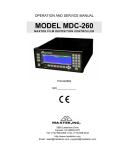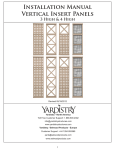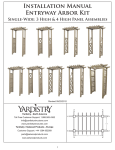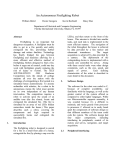Download PUMA2-- Short User Guide
Transcript
PUMA2– Short User Guide Detlev Droege 21.11.2007 Arbeitsgruppe Aktives Sehen (AGAS) Institut für Computervisualistik Universität Koblenz-Landau Universitätsstraße 1, 56070 Koblenz [email protected] http://www.uni-koblenz.de/∼droege Inhaltsverzeichnis 1 Introduction 1.1 Prerequisites . . . . . . . . . . . . . . . . . . . . . . . . . . . . . . . . . . . . . . . . . . . . . . . . . 3 3 2 Creating applications with PUMA2 2.1 Makefile . . . . . . . . . . . . . . . . . . . . . . . . . . . . . . . . . . . . . . . . . . . . . . . . . . . 2.2 Program . . . . . . . . . . . . . . . . . . . . . . . . . . . . . . . . . . . . . . . . . . . . . . . . . . . 2.3 Using the grabber library . . . . . . . . . . . . . . . . . . . . . . . . . . . . . . . . . . . . . . . . . . 3 3 4 4 3 Documentation 6 3 Document history Version 0.1 0.2 State in work in work Date 21.11.2007 30.11.2007 Author(s) DD DD Description initial version. added sample code. 1 Introduction This document describes the basic ’usage’ of PUMA2, that is the end user perspective to the packages provided e.g. as RPM packages. These contain libraries and header files to develop applications based on PUMA2. The term ’end user’ is meant from the perspective of the PUMA2 developer team. In this sense, end users are those developers using the PUMA2-Libraries to develop their own applications. 1.1 Prerequisites Currently, PUMA2-packages are distibuted as RPM files only. Following packages are available currently: libpuma2 This is the core library and must be installed in any case to develop PUMA2 based applications. It provides the basic image classes and a limited number of image operations. Currently, this package requires the presence of ImageMagick++, OpenCV, libpng and libjpeg. libpuma2grabber This package provides access to live video data. Based on the UniCap1 library it allows the use of cameras attached via FireWire, USB or specialized capture hardware. Obviously, all required packages have to be installed using the usual mechanisms (rpm or some high level package management tool like Yast2). The standard development tools expected are the GNU-C++ compiler suite (g++) and the GNU make program. 2 Creating applications with PUMA2 2.1 Makefile Unless an integrated development environment is used, which normally create makefiles on their own, the usage of makefiles for controlling the code generation is highly recommended. As PUMA2 provides the necessary information for the increasingly common tool pkg-config, writing makefiles is is quite simple. CXXFLAGS = $(shell pkg-config --cflags libpuma2) LIBS = $(shell pkg-config --libs libpuma2) SRC = minidemo.cc OBJS = $(SRC:.cc=.o) demo: $(OBJS) $(CXX) -o $@ $(CXXFLAGS) $(OBJS) $(LIBS) (Be sure to check that the indented command lines in the Makfile start with a TAB character, not with a series of blanks!) 1 http://unicap.sf.net/ 2.2 Program 4 2.2 Program The C++ program your write of course has to include some header files, like image classes and operations. In most cases (for now) you will use GrayLevelImage8 or ColorImageRGB8. An example: 1 2 3 4 5 6 7 8 9 10 11 12 13 14 15 16 17 18 19 20 21 22 23 24 25 26 27 28 29 30 31 32 33 34 35 36 37 #include <ColorImageRGB8.h> #include <ImageWriter.h> #include <ImageReader.h> using namespace Puma2_NS; int main (int argc, char **argv) { ColorImageRGB8 cin(0,0); std::string cfilename ("some-image.jpg"); ImageReader::readImage(cin, cfilename); int int int int pleft = cin.getWidth()/4; pright = 3*cin.getWidth()/4; ptop = cin.getHeight()/4; pbottom= 3*cin.getHeight()/4; for (int y = ptop; y < pbottom; y++) { cin[y][pleft][0] = 255; cin[y][pleft][1] = 0; cin[y][pleft][2] = 0; cin[y][pright][0] = 0; cin[y][pright][1] = 255; cin[y][pright][2] = 0; } for (int x = pleft; x < pright; x++) { cin[ptop][x][0] = 255; cin[ptop][x][1] = 0; cin[ptop][x][2] = 255; cin[pbottom][x][0] = 255; cin[pbottom][x][1] = 255; cin[pbottom][x][2] = 0; } ImageWriter::writeImage (cin, "marked-image.png"); } 2.3 Using the grabber library To capture images from live cameras, the PUMA2 extension library libpuma2grabber is used. After installing this additional package the following code should grab 50 frames from one of the attached cameras (you have to answer interactively which one to use). Store the following C++ source code as simpleGrabber.cpp. 1 2 3 4 5 6 7 8 9 10 11 12 13 14 /****************************************************** * a simple demo application using the puma2grabber * to read some frames into puma2 color images and write * them to disk * * Author: Benjamin Knopp <[email protected]> *****************************************************/ #include "GrabbingDeviceManager.h" #include "GrabbingDevice.h" #include <ColorImageRGB8.h> #include <ImageWriter.h> using namespace Puma2_NS; 2.3 Using the grabber library 15 16 17 18 19 20 21 22 23 24 25 26 27 28 29 30 31 32 33 34 35 36 37 38 39 40 41 42 43 44 45 46 47 48 49 50 51 52 53 54 55 56 57 58 59 60 61 62 63 64 65 66 67 68 69 70 71 72 73 74 75 76 77 78 5 using namespace std; // grab a maximum of 15 frames per second static const float FPS = 15.0; static const int NUM_FRAMES = 50; int main(int argc, char **argv) { // get instance of GrabbingDeviceManager GrabbingDeviceManager* myManager =GrabbingDeviceManager:: getGrabbingDeviceManager(); // check if supported devices are present if ( ! myManager->getNumDevices()) { cerr << "no supported devices found, sorry" << endl; return EXIT_FAILURE; } // list all supported devices myManager->printDeviceList(); unsigned int devNum = myManager->getNumDevices() +1 ; while ( devNum >= myManager->getNumDevices() ) { cout << "please enter device number" << endl; cin >> devNum; } GrabbingDevice *myCam; // connect to GrabbingDevice bool camFound = myManager->connectGrabbingDevice( &myCam, devNum ); if ( !camFound ) return EXIT_FAILURE; myCam->printFormatsList(); // choose first camera format which could be converted to rgb myCam->setFormat2("width=* height=* in=* out=RGB"); // start capture process myCam->startCapture(); // puma2 rgb image ColorImageRGB8 image; string filename; // capture for( int i { // // if { NUM_FRAMES frames = 0; i < NUM_FRAMES; i++ ) usleep( (int) (1000000.0 / FPS) ); // should be "minus grabtime" try to grab image and write it to disk ( myCam->grabImage( image )) cout << "\b\b" << toString(i) << flush; filename = "frame_" + toString( i ) + ".jpg"; // WARNING: writing png to disk is SLOW! ImageWriter::writeImage(image, filename.c_str()); } } // stop capturing process myCam->stopCapture(); delete myCam; return EXIT_SUCCESS; 6 79 } For the makefile, with respect to the one shown in section 2.1, it is sufficient to change the pkg-config package parameter to libpuma2grabber, as this will automatically include libpuma2 (and other libraries needed) as well. 1 2 3 4 5 6 7 8 9 10 11 12 13 INCPATH = $(shell pkg-config --cflags libpuma2grabber) LIBPATH = $(shell pkg-config --libs libpuma2grabber) CXXFLAGS LDFLAGS = -g -O2 $(INCPATH) = -g $(LIBPATH) all: simpleGrabber simpleGrabber: simpleGrabber.o $(CXX) simpleGrabber.o $(LDFLAGS) $(CXXFLAGS) -o simpleGrabber clean: -rm simpleGrabber simpleGrabber.o 3 Documentation ... is currently very poor. Please refer to the doxygen-generated API description at http://www.uni-koblenz.de/puma/doc.















